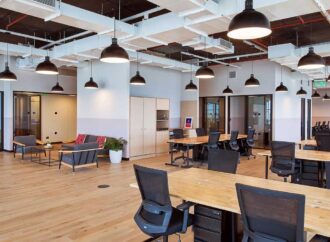Data analytics transforms the coworking industry by optimising operational efficiencies, enhancing user experiences, and enabling predictive analytics for strategic planning. It delves into advanced tools like CRM systems and IoT sensors to analyze trends and personalise services based on member needs while addressing privacy and ethical data use challenges.
The Intersection of Data Analytics and Coworking Spaces
Integrating data analytics into coworking spaces stands out as a game-changer in a world where work boundaries are continually redrawn.
Data analytics emerges as a pivotal force as the coworking sector thrives, driven by the increasing demand for flexible, innovative workspaces. This enhances operational efficiencies, enriches user experiences, and paves the way for more informed decision-making.
In this deep dive, we explore how data analytics complements and catalyses the growth and transformation of the coworking industry.
Understanding Data Analytics | Key Concepts and Tools
Data analytics involves extensive processes where vast amounts of data are collected, analysed, and transformed into actionable insights.
For coworking spaces, this can mean analysing usage patterns to optimise space, tailoring services to member preferences, and predicting future trends that could impact growth.
Essential tools in this process include :-
- Advanced CRM systems.
- IoT sensors for real-time space usage tracking.
- Sophisticated data processing & visualising software that can handle complex datasets efficiently.
What Coworking Spaces Learn from Analytics
Data analytics provides a wealth of information for coworking operators. It enables them to monitor daily foot traffic, identify the most frequently used areas of the space, and determine when peak occupancy occurs.
This data is crucial for effectively managing resources and ensuring that spaces are available and arranged in a way conducive to the activities they host.
Trends & Patterns
Coworking spaces can analyse data over time to identify macro and micro trends. For instance, data analysis may reveal a growing preference for a particular micro market or an increase in the usage of coworking spaces among corporate teams. This information can be used to build more coworking spaces in that particular location or design spaces that cater to collaborative projects.
Furthermore, understanding member preferences granularly, such as their favourite workstations or coffee preferences, can enhance the overall customer experience.
Optimising Space and Resources
Space optimization is essential in coworking environments. Data analytics can help understand how different areas are used, creating a layout that maximises comfort and productivity.
For example, if analytics show that quiet zones are frequently used, management might consider expanding these areas or providing additional features, such as soundproofing, to enhance their functionality.
Enhancing Member Experience
Data analysis can optimise physical resources and improve the services offered by coworking spaces. By analysing user feedback and behaviour, personalised services can be provided, such as preferred desk settings and customised workshops and event invitations that align with members’ professional interests.
Pricing Strategies
Dynamic pricing models are gaining popularity in the coworking industry. These models use data to adjust prices based on several factors, such as demand, duration of use and member loyalty. Implementing such strategies ensures that prices remain competitive while also reflecting the actual value of the services provided.
This segment will explain how coworking spaces leverage data to fine-tune their pricing strategies, ensuring they attract new users without compromising profitability.
Predictive Analytics
Predictive analytics is a proactive approach utilised by coworking spaces to plan for their future. By analysing trends and gauging member satisfaction, they can predict the demand for their services in different regions, evaluate the viability of opening new locations, and foresee which services will become more popular.
This capability enables them to expand their presence in the market strategically, staying ahead of members’ requirements and competitive pressures.
Challenges and Considerations in Data-Driven Coworking Spaces
While incorporating data analytics in coworking spaces brings numerous advantages, it poses some significant challenges. Privacy concerns are the most crucial issue to address since the collection and use of data must comply with legal requirements and safeguard member privacy.
Coworking spaces must ensure robust data security measures are in place to protect sensitive information. Moreover, there is a risk of data bias and inaccuracies that could result in ill-informed decisions negatively impacting the user experience or operational efficiency.
Navigating Ethical Use of Data
Coworking operators must establish transparent data usage policies and communicate them clearly to members. Ensuring data is used ethically builds trust and strengthens the community by aligning the business operations with member expectations and values.
Technological Integration
The role of technology in coworking spaces extends beyond basic data analytics. Integrating AI, machine learning, and IoT devices can further enhance the management and personalisation of coworking environments.
For instance, IoT sensors can automate conditions like lighting and temperature based on real-time occupancy data. At the same time, AI can help manage resource bookings and member interactions without human errors.
The Future of Coworking | Data-Driven Strategies and Innovations
The coworking industry is expected to become more advanced in its use of data analytics in the future. Advancements such as predictive AI models allow for even more accurate forecasting of market demands.
At the same time, behavioural analytics provides more profound insights into how physical and social environments impact productivity and creativity in coworking spaces.
Sustaining Community and Collaboration in a Data-Driven Age
As coworking spaces continue to develop, focusing on community and collaboration is crucial. Data analytics should be leveraged to enhance these aspects rather than undermine them.
For instance, data can help identify shared interests among members, thereby facilitating the creation of special interest groups or events that promote networking and collaboration.
Bottom Line
The coworking industry is revolutionising with the integration of data analytics. Coworking spaces use data-driven insights to optimise physical and operational aspects and improve the overall member experience.
Coworking spaces can adapt quickly to users’ changing needs as technology advances, creating smarter environments.























